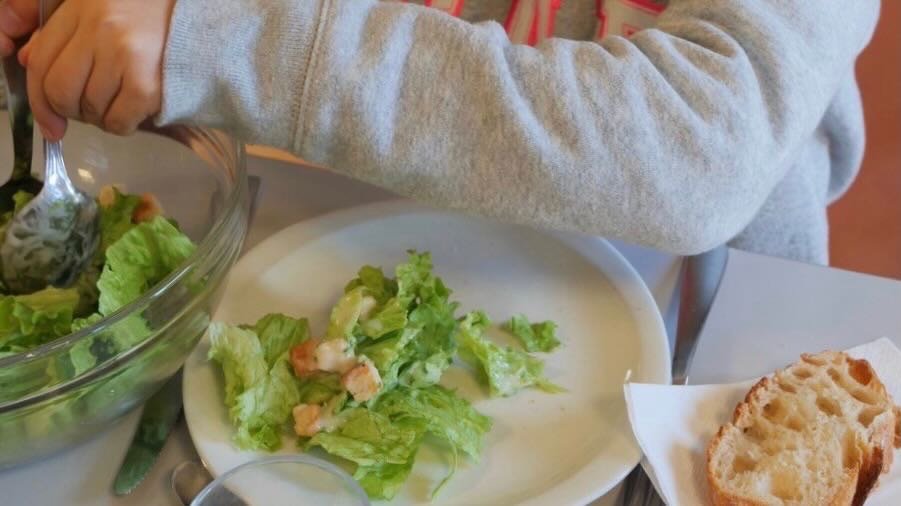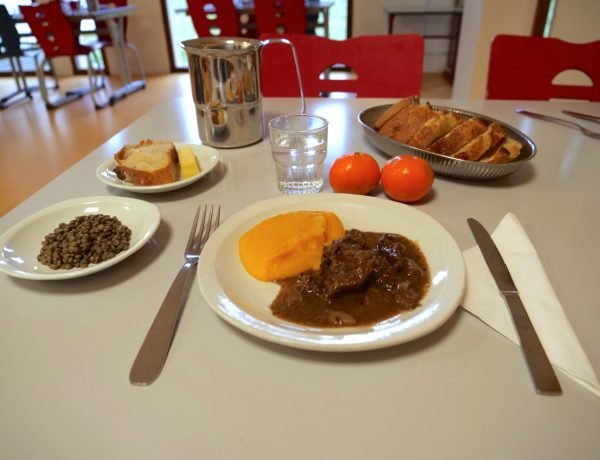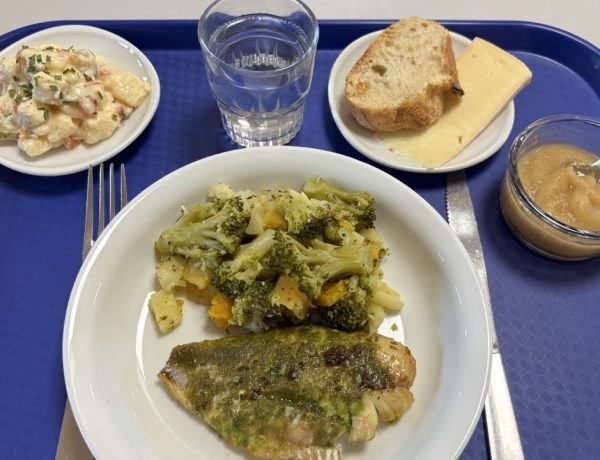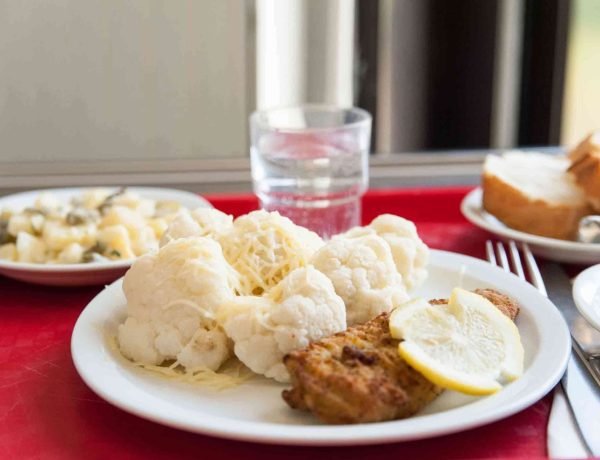When my daughter was between eighteen months and three years old, she attended our local daycare a few half-days a week here in our small town near Lake Annecy. Some mornings I dropped her off early; other days I arrived just before lunch. Either way, I found myself lingering at the doorway, absorbing the scene in front of me. French toddlers eat everything at lunchtime.
What I saw each time stopped me: tiny tables, tiny chairs, six to eight toddlers sitting together, and at least one or two adults helping — but not spoon-feeding or coaxing. The children ate off real trays or small plates and drank water from actual glass cups. They wore bibs, sat calmly, and focused on their food with a steadiness that always surprised me.
It was the calm more than anything. No chaos, no bribing, no “one more bite.” Just little children eating lunch together as if it were the most natural ritual in the world.
The journalist in me needed to understand how this peaceful mealtime “magic” worked — partly for an article forming in my mind, and partly because I was raising three young children of my own and dreaming of calmer meals at home.
So I set up a long conversation with the daycare director, Catherine Colin, who walked me through how French toddlers learn to eat so well — long before they ever arrive at preschool or sit down to their first cantine scolaire lunch.
What she shared reshaped everything I thought I knew about feeding toddlers.
For a complete overview of the French school lunch system, see → French School Lunches: How They Work Today.
The French Starting Point: Vegetables Are Essential, Not Optional
Catherine began with a simple cultural truth: in France, vegetables are essential to cuisine, health, and daily life. They’re not hidden, not disguised, and not treated as something to negotiate.
Once you accept this starting point, she told me, the next step is helping children recognize foods — by sight, smell, texture, and taste.
Recognition → confidence.
Confidence → willingness to taste.
Tasting → liking.
That progression guides everything.
Here are the practices that stood out most. → Click here to read about France’s most important healthy eating habits.
1. Keep Meals Simple and Easy to Recognize
This was the first thing Catherine emphasized:
A child needs to know what they’re eating.
Food in French daycares is deliberately simple. Vegetables aren’t hidden in sauces or turned into cartoon shapes. Instead, toddlers see foods exactly as they are: grated carrots, cooked green beans, slices of beetroot, steamed zucchini, small servings of fish or chicken.
Simple → visible → recognizable → acceptable.
If you want to see how foods for the kids are prepared, read on → The Inside Of A French School Kitchen (in photos!)
2. Offer All the Foods at Once
In daycares, meals for under-threes are typically served on a divided plate with small portions of:
- a starter
- a main dish
- a dairy item
- a dessert
Toddlers choose their own eating order. Some begin with dessert — and surprisingly, that’s fine. Caregivers know that exposure to all the foods matters more than enforcing rules.
By the time preschool begins and courses are served one by one, the foundation for food recognition has already been built.
3. Let Children Grow Their Own Foods
Many French daycares and preschools include small gardens or containers with herbs. Children plant seeds, water them, and watch them grow. Later, they harvest and taste what they’ve grown.
A toddler who has helped grow a carrot is naturally more curious about eating a carrot.
It’s a quiet but powerful form of exposure.
4. Cook With the Children
I loved this part of the French approach. Even toddlers participate in food preparation: peeling apples, washing lettuce, stirring soups, shaping dough, chopping soft vegetables with child-safe knives.
When children help cook, they feel responsible for the food.
And when they feel responsible, they want to taste.
Cooking becomes another layer of recognition.
Join my free monthly newsletter
for everyday French life, simple habits & sustainable wellbeing.
And get The French Guide to Everyday Wellbeing straight to your inbox!
5. Let Food Appear Throughout the Day (Not Just at Meals)
In French early-childhood settings, food is part of the daily environment: play kitchens, pretend food markets, wooden fruits and vegetables, cooking role-play.
Children “cook,” “serve,” and “taste” all day long in their pretend world.
So by the time a real vegetable appears on their plate, it already feels familiar.
The Real Secret: Repeated, Calm Exposure
French caregivers expect that children may need 7–15 exposures to a new food before liking it. No one rushes the process. No one labels a food as “not liked” after two refusals.
The food simply returns, in a calm, predictable way.
After observing the daycare and talking with Catherine, I continued serving varied foods at home — but I adjusted my expectations. I stopped assuming early refusals meant anything at all. I gave my children more time, more chances, more calm.
And in the end, it worked. Their palates widened naturally, thanks to the combination of daycare, school meals, and what we served at home.
(Though yes — I waited a long time before offering real glass cups at home.)
To understand all the lessons being taught at the daycare, read → 5 Reasons French School Lunches Are Important (It’s Not The Food)
FAQ: How French Toddlers Learn to Eat Everything
Why do French toddlers eat everything, or do they really?
Not everything — but they are consistently exposed to a wide range of foods, especially vegetables, from the time they start daycare. Repetition + calm = acceptance.
Why do French children drink from glass cups?
Glass teaches toddlers to handle objects carefully and signals that mealtime is important and civilized — even for very young children.
Do French caregivers force children to eat vegetables?
No. They offer, re-offer, and model. Exposure is prioritized over pressure.
What happens when a toddler refuses a food?
Nothing dramatic. The food returns another day. Repeated calm exposure is the strategy.
Is this the same approach used in French preschools and elementary school cafeterias?
Yes — this early foundation helps children transition seamlessly into the structured, multi-course meals served in French preschools and elementary schools.
More From France
If you’re curious about how France nurtures healthier habits — from school lunches to everyday food, movement, and wellbeing — I share practical tips and stories each month. Sign up for the free newsletter below and receive my guide, The French Guide to Everyday Wellbeing, straight to your inbox. Merci!




